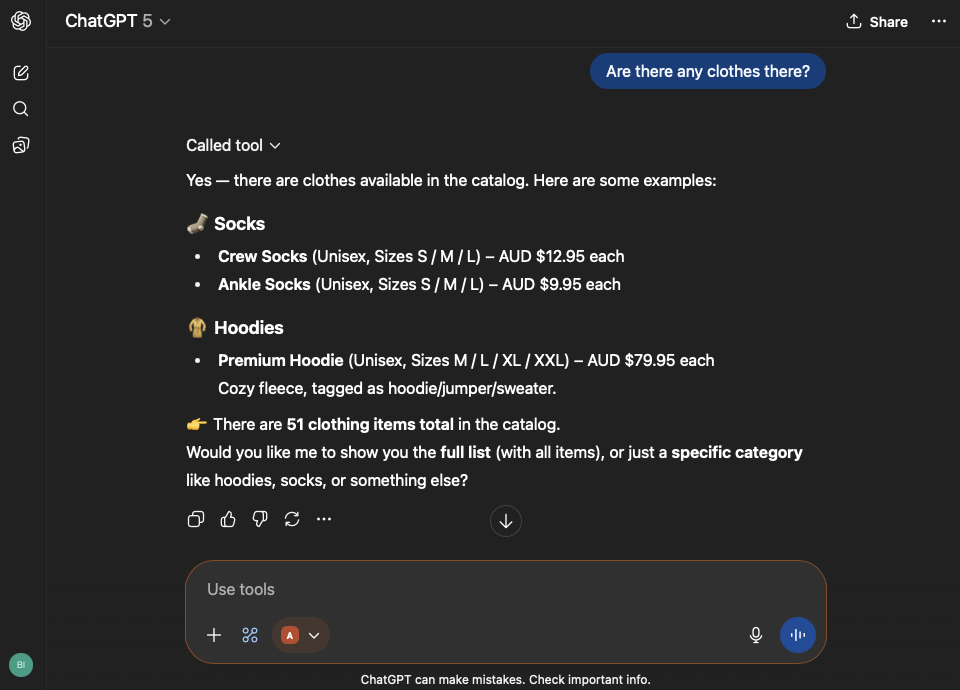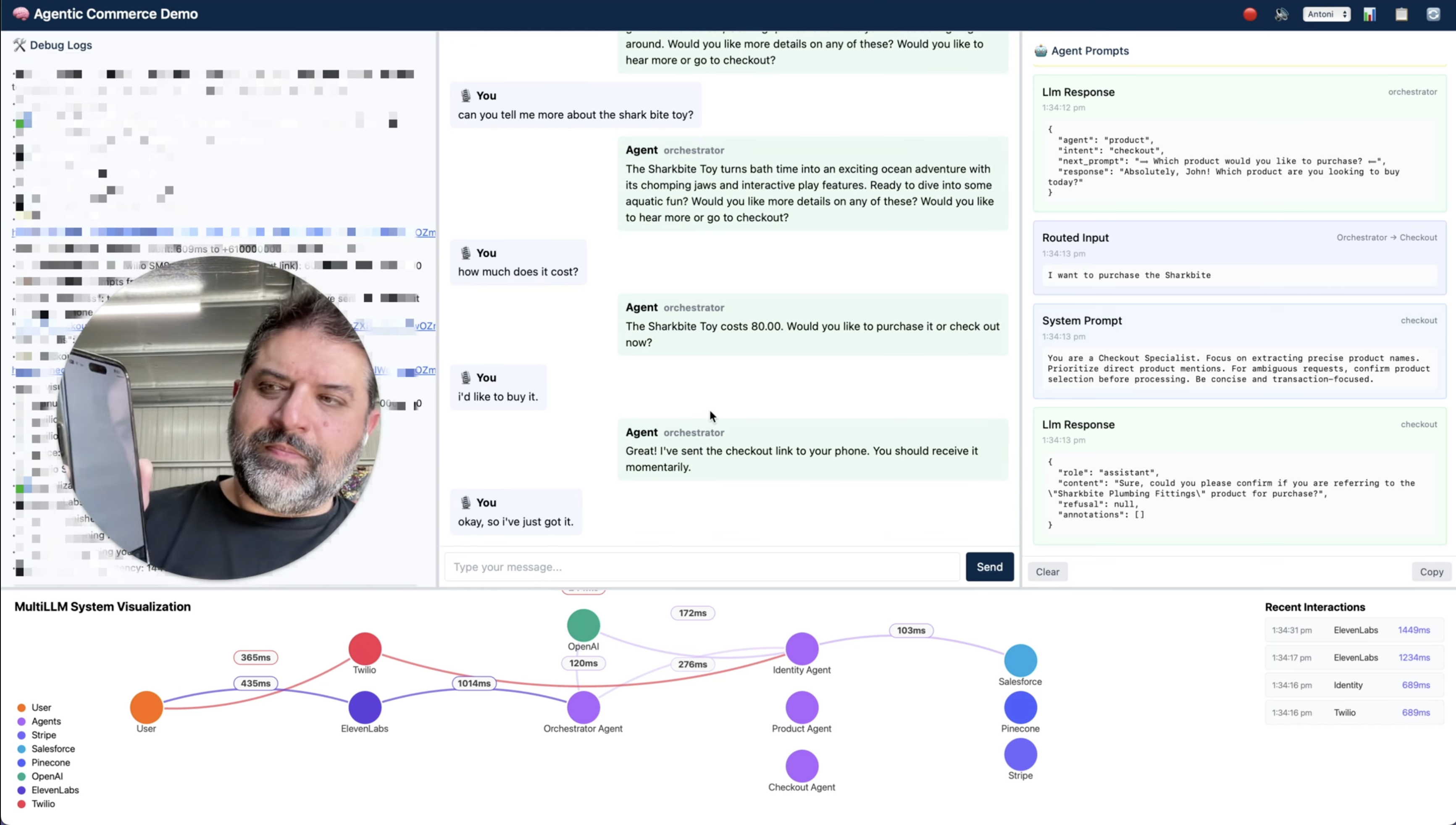Shawn Durrani
Solution Architect
MCP Merchant — Public MCP server for agentic commerce
15 Sep 2025
Agents don’t yet have a reliable way to discover agent‑friendly, merchant‑run surfaces. MCP Merchant shows how the Model Context Protocol Registry can advertise a safe, hosted commerce surface that agents can find and use immediately. It’s read‑only, backed by Stripe test‑mode data, and bounded so it’s safe to try in the open. SSE endpoint (shown here as text): https://mcp.shawndurrani.ai/sse.
Why I built it this way
There’s a missing link between discovery and first use for agentic commerce. The pattern here is simple: publish to the MCP Registry (standardised metadata), host a minimal SSE endpoint, and expose a couple of useful, safe tools over a real catalogue. That connects discovery → connection → capability without bespoke connectors or a full app. It’s intentionally small and production‑shaped so a team could copy it tomorrow.

Stack
- MCP server (namespace:
ai.shawndurrani/mcp-merchant, v0.1.1) - Transports: hosted SSE and local stdio (NPM)
- Stripe Products/Prices (test mode) as the catalogue
- In‑memory cache (~94 items, AUD)
- Tools:
health,searchProducts
What it does
- Exposes safe, read‑only product search for agent workflows
- Simple substring matching over name/description with pagination
- Designed for quick trials in ChatGPT MCP and the MCP Inspector
Try it
- ChatGPT (Web) → Settings → Developer → Model Context Protocol → Add Server → Type: sse → URL:
https://mcp.shawndurrani.ai/sse. Start a new chat, then runai.shawndurrani/mcp-merchant.healthand...searchProducts. - CLI (Inspector):
npx -y @modelcontextprotocol/inspector@latest --sse https://mcp.shawndurrani.ai/sse - Registry Explorer: mcp.shawndurrani.ai/explore
- Health (JSON): mcp.shawndurrani.ai/healthz
Safety
- Stripe test mode only; no PII
- Results bounded: pageSize ≤ 20; query length limited
- Cache limited by product cap; safe defaults
Built to make agent experiments practical without touching production systems.
Agentic Commerce Demo – Voice-first LLM Checkout
2 Aug 2025
This is a third rewrite of a demo I've been experimenting with that explores agent-driven commerce using real tools. It started as a Python and HTML project, then moved to JavaScript and React once I hit limitations around orchestration, latency and modularity.
The core idea was to see if an LLM-based agent could guide a user through onboarding, product selection, and payment – all through voice – without relying on a traditional frontend or support flow.
Stack
- OpenAI GPTs for both orchestrator and specialist agents
- ElevenLabs for speech-to-text and text-to-speech
- Pinecone as the vector store for product recall and metadata
- Stripe Agent Toolkit for product catalogue and checkout links
- Salesforce as the customer record system
- Twilio for OTP
- Node.js as the backend layer
- ngrok to expose webhooks
What it does
- New user: Onboards via voice, sets up identity, verifies via OTP, browses products, and receives a checkout link
- Returning user: Recognised by phone number, verified again, and taken straight to purchase using a stored payment method
Everything is voice-driven and agent-orchestrated, from start to finish.
What went wrong
- Prompt structure was too fragile – especially around product handoff
- Agents would hallucinate product names or miss lookup steps
- Too much logic in prompt instructions made behaviour hard to debug
- Race conditions between OTP verification, Salesforce creation, and Stripe checkout
- Voice UX was inconsistent – speech-to-text accuracy was unreliable and latency was too high for fluid use
Why I built it this way
I avoided using vertical stacks on purpose. I wanted something composable, using real APIs that reflect what startups or teams might reach for. I also don't write code the traditional way – most of this was done through iterative prompt design, test scaffolding, and pairing with LLMs via Cursor or Claude Code.
This isn't meant to be polished. It's functional, testable, and closer to what you might build internally for validation or customer education.
Watch the demo
Agentic Commerce Demo with Stripe Agent Toolkit
About
I'm a Partner Solution Architect at Stripe, working with APAC partners and startups to scale fintech adoption and close complex deals. Lately, I've been focusing on how large language models and agentic systems are reshaping commerce.
Most of what I build isn’t traditional engineering — it’s systems design through LLMs, APIs and tools that let me test ideas quickly. Outside of Stripe, recent experiments include technology from OpenAI, Twilio, Pinecone, Salesforce, as well as voice interfaces like ElevenLabs. I use Cursor, Claude Code and Codex CLI to explore things like memory, prompt routing and agentic payment orchestration.
This site shares a mix of internal experiments (illustrated where possible) and external prototypes. The focus is on real architecture, working flows and the practical challenges that come with building agentic systems.
Outside of work, I spend time with my family, ride mountain bikes badly downhill and think about how GenAI changes platform design and developer tooling.
This site is a lightly chaotic trail of what I’m building, learning and occasionally getting wrong. Thanks for visiting!
